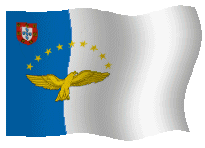LIVING IN THE AZORES

*
A
Little About My Life in Paradise
on the Island
of São
Miguel
*
(This page may take a while to load, so please be patient)

*
|
LIVING IN THE AZORES
|
||||
|
|
* A
Little About My Life in Paradise * (This page may take a while to load, so please be patient)
|
|
||
|
* |
||||
FIRST VISIT
|
My first visit to the island was an exploratory one. I had been invited by a friend to come and spend three weeks to get to know the island before I made up my mind whether I was going to move there after resigning my teaching post. I arrived on the
morning of 29 December 1999 after flying there via Vienna, Barcelona and
Lisbon. My first glimpse of the island was of the town of Lagoa as the
plane descended out of the clouds. It was a view that took my breath
away: lush green hills, the white of the houses with their orange roofs,
the dark blue-grey wintry sea... I immediately fell in love with the
place. |
|||
| We had been fortunate enough to be able to rent a cottage on the shore of the Blue Lake (Lagoa Azul) of Sete Cidades. Between the verandah and the lake lay a small front garden, the narrow gravel road and a stretch of grass -- all less than 50 metres! It was the most idyllic place imaginable to stay and I was very sorry that we could not spend more time in the cottage itself, but there was so much to be seen, people to meet and places to go... |
|
|
|
|
|
|
||
|
In those weeks we travelled all over the island during the days, and at night we had dinners with São Daily I was amazed anew by the beauty of the landscape, and the diversity of the scenery that awaits the explorer around every corner of this green paradise. And as our friendship deepened, I knew that this was where I wanted to be: on this island with São and all the new friends I had made amongst the people here. |
|||
The coastline varies tremendously: the south coast is generally low and marked by many beaches of dark basalt sand, whereas the north coast is very rocky with numerous steep cliffs. Beaches here are fewer and more difficult to reach, but well worth the tramp down steep, narrow and twisting footpaths. The east coast between Nordeste and Faial da Terra is very similar. Along the north coast the shores are generally densely wooded, too, with mostly cryptomeria, pittosporum and metrosideros trees, as well as patches of the indigenous trees and scrub. These are always green, even in the driest periods (which are very rare). Most roads hugging the north coast, as elsewhere on the island, are lined by plane trees, with azaleas, cannas, hydrangeas and belladonna lilies adding colour to the roadsides. Many of these roads are still cobblestoned, but sadly they are being resurfaced in asphalt -- the traffic is too heavy nowadays. |
|||
|
I also saw most of all the usual tourist attractions, of course, and we spent a few days in the city of Ponta Delgada itself. It is a delightful city with its narrow cobblestoned streets, the vibrancy of colour and human movement and all the very old buildings far outnumbering the modern ones in the central area. Wandering through the streets of Ponta Delgada was to become one of my favourite passtimes. And everywhere there are the little cervejarias (literally "beer shops", but they are more like bistros or tiny restaurants) where one can have anything from a full meal to a snack like a tosta mista (toasted ham and cheese) or prego (a roll with a thin slice of beef or pork) and to wash it down with anything from mineral water to a 12-year-old single malt whisky, not to mention freshly brewed coffee, local or imported beers or the many excellent wines from mainland Portugal. All too soon my first visit drew to an end, but I had made up my mind that I was going to return... There were just some loose ends to tie up in South Africa.
|
|||
|
|
|
||
|
THE STAY I arrived back on the island early in April 2000. Now began one of the happiest periods in my life, the stresses and strains of teaching teenagers were behind me and ahead lay a new life amongst the warm-hearted Azoreans and in new and serene surroundings. While I was back in South Africa São had been hunting for a place for us to live, and she found a little house in the very aptly named Rua da Alegria (Happiness Street) in the eastern part of the city centre, a mere five minutes' walk from the main shopping centre and close to the harbour and the old Forte de São Brás (early 17th c), built to defend the city and port against pirates. One disadvantage of the house was that it was small, another that we lay directly under the approach path of airliners to the airport, about five kilometres further east. But it was a good place to start while we were on the look-out for something better. |
|||
|
Living on the island had its challenges: I had to start learning Portuguese pretty quickly, as many people don't know enough English or are shy to speak the language. Luckily I was soon able to make myself understood well enough for visits to the shops, banks or coffee shops and restaurants. Shopping is a dream; there are two very large hypermarkets on the outskirts of the city (but still within walking distance of our house), a supermarket and a shopping centre on the Avenida Dom Infante Henrique which runs between the harbour and the city, and plenty of smaller shops where one can buy anything from toothpicks to all sorts of liquor, as well as vegetables and groceries. There is also a large cah and carry store near the city centre, and of course all the other shops one could wish for, and many of them too! Shopping hours are normally from 10 am to 8 pm, but the hypermarkets and larger supermarkets are open from 9 am to 11 pm every day of the week, except Sundays when they close at 10 pm. All autoteller machines are open 24 hours a day, as are the filling stations, where one can also buy bottled petroleum gas for stoves or hot water geysers. |
|||
|
Exploring
the city on foot is an experience not to be missed and there is much to see.
The main churches are the Matriz de São
Sebastião |
|||
|
These old buildings are all constructed from the local basalt, hence the dark grey to black colour, and the walls are often stuccoed and painted white. Even today basalt forms a major building material on the islands. Sine Santa Maria is the only island with any clay deposits, ordinary bricks are very scarce and expensive. Walls that are to be plastered are therefore built with cement blocks. As the only sand available is also of basalt origin, even the mortar and plaster used has the traditional dark colour. Basalt, when freshly cut, is actually light grey in colour, weathering to almost black, as can be seen in the paving and coping stones on the sea wall alongside the Avenida (photo above). The paving of the pavements is also traditionally Portuguese, and can be seen in other former Portuguese territories like Goa, Mozambique and Angola, as well as of course in all mainland Portuguese towns and cities. Even in Brazil there are still examples of this kind of paving, using basalt and white flint. |
|
||
|
The majority of buildings in the old part of the city
are well over 200 years old. There are a number of new buildings, of course,
which do not always fit in very well with their older surroundings, as can
be seen in this photograph (left) of the former Convento da Graça, which
now houses a municipal art gallery, against the backdrop of the towering
modern building of the Centro Comercial Sol Mar, the main shopping centre in
the central city.
The old building also shows the effect of the high
rainfall on the limewashed walls. Just behind and to the left of the main
building of the old convent is the site of the modern vegetable market where
everything from fruit to flowers can be bought at very reasonable prices.
The market also houses a butchery and souvenir shops. There is a
large car park under the market, too.
|
|||
|
|
|
||
|
Then we found this wonderful little cottage to rent in Pópulo, about 5km outside the city on the way to Lagoa. It was not cheap, but the positioning made it worth the extra rent. As you can see we were right on the beach of the Praia Pequena do Pópulo. (The cottage is the first white building visible on the left in the photo above) Here we were to be very happy indeed, and although the place was very small, our many friend used to love to come and visit us here. It was truly wonderful to have the sound of the sea in around us all the time and to wake up to the birds singing in the tall meterisedros and tamarisk trees around the cottage. We even had our own little miradouro or look-out point set in the sea wall between the cottage and the beach. Here I would spend hours carving sculptures, have my early morning coffee every morning and sit -- a Scotch on the rocks or beer in hand -- and watch the sun setting across the little bay and over the city on the horizon. Our Pointer Maggie and the seven cats also enjoyed the setting tremendously. Only about 100 metres away was the bar -- a little restaurant cum café -- where my dear friend António and I spent hours drinking coffee (he) and beer (I) and talking or just watching the activities on the beach. |
|||
|
|
|
||

UNDER CONSTRUCTION